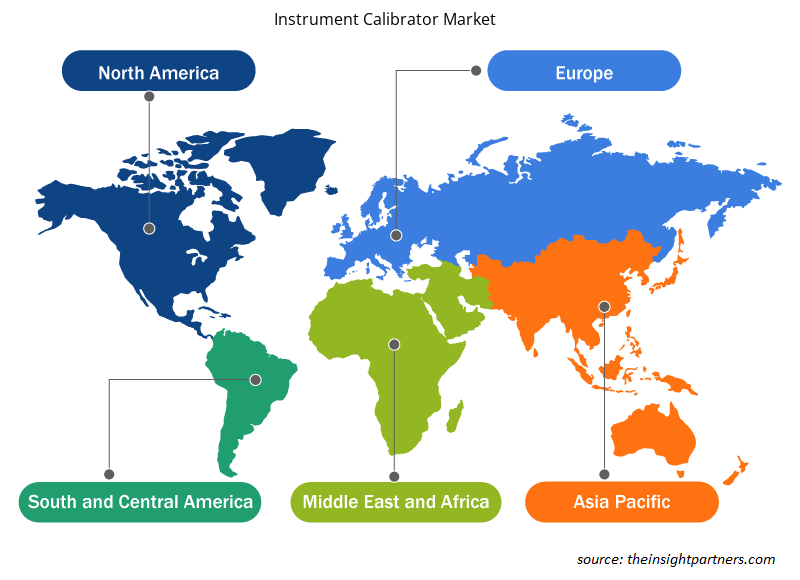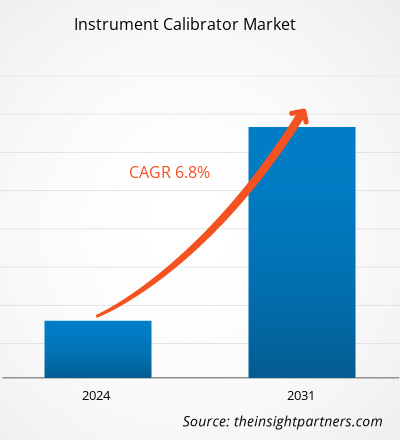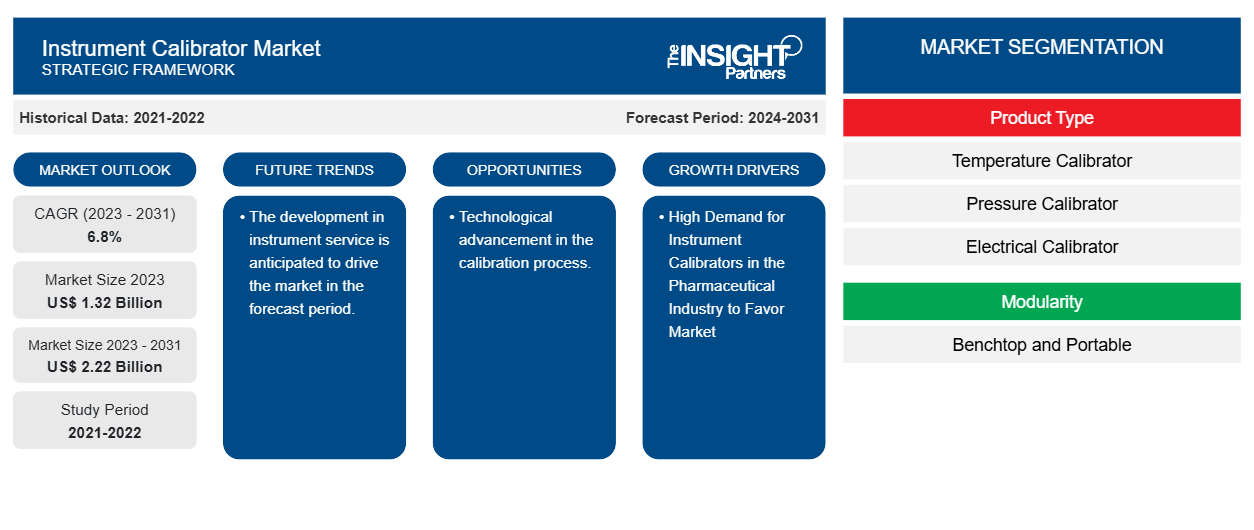Se proyecta que el tamaño del mercado de calibradores de instrumentos alcance los 2220 millones de dólares estadounidenses en 2031, frente a los 1320 millones de dólares estadounidenses en 2023. Se espera que el mercado registre una CAGR del 6,8 % durante el período 2023-2031. Es probable que la creciente demanda de la industria farmacéutica y el avance tecnológico y la asequibilidad de los calibradores sigan siendo tendencias e impulsores clave en el mercado.
Análisis del mercado de calibradores de instrumentos
Se prevé que la demanda del mercado de calibradores de instrumentos aumente debido a la creciente demanda de la industria farmacéutica, aeroespacial y de defensa. Además, se prevé que diversas regulaciones gubernamentales, avances tecnológicos y calibración de instrumentos impulsen el mercado en los próximos años.
Descripción general del mercado de calibradores de instrumentos
La calibración de instrumentos es una parte importante de cualquier sistema de medición, ya que garantiza que los instrumentos funcionen correctamente y proporcionen lecturas precisas. Es el proceso de comparación entre las lecturas de un instrumento y las proporcionadas por un instrumento de referencia o calibrador. La calibración ayuda a garantizar la confiabilidad, la precisión, la seguridad y el cumplimiento de las normas de la industria.
Personalice este informe según sus necesidades
Obtendrá personalización en cualquier informe, sin cargo, incluidas partes de este informe o análisis a nivel de país, paquete de datos de Excel, así como también grandes ofertas y descuentos para empresas emergentes y universidades.
-
Obtenga las principales tendencias clave del mercado de este informe.Esta muestra GRATUITA incluirá análisis de datos, desde tendencias del mercado hasta estimaciones y pronósticos.
Impulsores y oportunidades del mercado de calibradores de instrumentos.
Alta demanda de calibradores de instrumentos en la industria farmacéutica favorecerá el mercado
La calibración de instrumentos es una actividad crítica de BPM en la industria farmacéutica. Garantiza mediciones precisas de instrumentos críticos y ayuda a mantener la calidad y seguridad del producto. Este proceso implica comparar los instrumentos con estándares conocidos para verificar la precisión dentro de las tolerancias especificadas. Las plantas farmacéuticas pueden funcionar sin calibración. Sin embargo, cumplir con las estrictas regulaciones EMEA/FDA y las normas ISO, sin mencionar la enorme cantidad de instrumentos que requieren calibración regular, puede ser un proceso costoso y que requiere mucho tiempo. Se generan y archivan grandes cantidades de datos de calibración, que deben ser fácilmente accesibles, especialmente en caso de una auditoría. Esto crea una enorme demanda de calibración de instrumentos, lo que impulsa aún más el crecimiento del mercado.
Avance tecnológico en el proceso de calibración.
Los avances tecnológicos en el proceso de calibración ofrecen inmensas oportunidades. A medida que aumenta la demanda de software automatizado para mejorar la precisión y la eficiencia del proceso, el software de automatización de calibración se puede utilizar para convertir los procesos y procedimientos manuales en tareas de bajo contacto o incluso sin contacto. Además, la inteligencia artificial para el aprendizaje profundo y la calibración inteligente está ganando terreno. Se identifican nuevas aplicaciones de estas herramientas a diario, y la calibración es uno de los muchos sectores que se benefician de este auge tecnológico. Por lo tanto, debido a los parámetros anteriores, se prevé que el avance tecnológico en el proceso de calibración impulse el crecimiento del mercado en los próximos años.benefitting from this technology boom. Thus, owing to the above parameters, technological advancement in the calibration process is anticipated to fuel the market growth in coming years.
Análisis de segmentación del informe de mercado de calibradores de instrumentos
Los segmentos clave que contribuyeron a la derivación del análisis del mercado de calibradores de instrumentos son el tipo de producto, la modularidad y la vertical de la industria.
- Según el tipo de producto, el mercado de calibradores de instrumentos se divide en calibradores de temperatura , calibradores de presión, calibradores eléctricos y calibradores de procesos multifunción. Se prevé que el segmento de calibradores de temperatura tenga una participación significativa en el período de pronóstico.
- Basado en la modularidad, el mercado de calibradores de instrumentos es de sobremesa y portátil. Se prevé que el segmento portátil ocupe una participación significativa en el período de pronóstico.
- Por sector industrial, el mercado está segmentado en automoción, aeroespacial y defensa, electrónica, alimentos y bebidas, farmacéutica, petróleo y gas, entre otros. Se prevé que el segmento automotor tenga una cuota de mercado significativa en el período de previsión.
Análisis de la cuota de mercado de los calibradores de instrumentos por geografía
El alcance geográfico del informe del mercado de calibradores de instrumentos se divide principalmente en cinco regiones: América del Norte, Asia Pacífico, Europa, Medio Oriente y África, y América del Sur y Central.
América del Norte ha dominado el mercado. América del Norte comprende países como Estados Unidos, Canadá y México. La región está experimentando un crecimiento sustancial debido a factores como la disponibilidad de calibradores de instrumentos portátiles y de sobremesa en las economías desarrolladas y en desarrollo. Además, el alto uso de calibradores portátiles debido a su interfaz fácil de usar y precios asequibles está aumentando su demanda a nivel mundial. Además, el enfoque en la investigación y el desarrollo está aumentando el avance tecnológico en la región. Además, la región tiene una gran cantidad de fabricantes clave en el mercado. Por lo tanto, debido a todos estos parámetros, el mercado está ganando terreno en América del Norte.
Perspectivas regionales del mercado de calibradores de instrumentos
Los analistas de Insight Partners explicaron en detalle las tendencias y los factores regionales que influyen en el mercado de calibradores de instrumentos durante el período de pronóstico. Esta sección también analiza los segmentos y la geografía del mercado de calibradores de instrumentos en América del Norte, Europa, Asia Pacífico, Oriente Medio y África, y América del Sur y Central.

- Obtenga datos regionales específicos para el mercado de calibradores de instrumentos
Alcance del informe de mercado de calibradores de instrumentos
| Atributo del informe | Detalles |
|---|---|
| Tamaño del mercado en 2023 | 1.320 millones de dólares estadounidenses |
| Tamaño del mercado en 2031 | US$ 2.22 mil millones |
| CAGR global (2023 - 2031) | 6,8% |
| Datos históricos | 2021-2022 |
| Período de pronóstico | 2024-2031 |
| Segmentos cubiertos |
Por tipo de producto
|
| Regiones y países cubiertos |
América del norte
|
| Líderes del mercado y perfiles de empresas clave |
|
Densidad de actores del mercado: comprensión de su impacto en la dinámica empresarial
El mercado de calibradores de instrumentos está creciendo rápidamente, impulsado por la creciente demanda de los usuarios finales debido a factores como la evolución de las preferencias de los consumidores, los avances tecnológicos y una mayor conciencia de los beneficios del producto. A medida que aumenta la demanda, las empresas amplían sus ofertas, innovan para satisfacer las necesidades de los consumidores y aprovechan las tendencias emergentes, lo que impulsa aún más el crecimiento del mercado.
La densidad de actores del mercado se refiere a la distribución de las empresas o firmas que operan dentro de un mercado o industria en particular. Indica cuántos competidores (actores del mercado) están presentes en un espacio de mercado determinado en relación con su tamaño o valor total de mercado.
Las principales empresas que operan en el mercado de calibradores de instrumentos son:
- Compañía AMETEK Inc.
- Compañía Baker Hughes
- Instrumentos Extech
- Corporación Fluke
- Corporación eléctrica Yokogawa
- WIKAAlexander Wiegand SE & co. kilos
Descargo de responsabilidad : Las empresas enumeradas anteriormente no están clasificadas en ningún orden particular.

- Obtenga una descripción general de los principales actores clave del mercado de calibradores de instrumentos
Noticias y desarrollos recientes del mercado de calibradores de instrumentos
El mercado de calibradores de instrumentos se evalúa mediante la recopilación de datos cualitativos y cuantitativos a partir de investigaciones primarias y secundarias, que incluyen publicaciones corporativas importantes, datos de asociaciones y bases de datos. A continuación, se enumeran algunos de los avances en el mercado de calibradores de instrumentos:
- ABB ha comenzado la construcción de una nueva sala de calibración de 1100 metros cuadrados en el parque industrial adyacente a su planta de fabricación de 18.000 metros cuadrados en Bartlesville, Oklahoma. La inversión fortalecerá las capacidades de calibración de la empresa y ofrecerá a los clientes altos niveles de calidad y precisión en la gama completa de caudalímetros de ABB. También aumentará aún más la oferta "Made in America" de la empresa. (Fuente: sitio web de la empresa ABB, enero de 2024)
- Dracal Technologies anunció la firma de un acuerdo entre Dracal Technologies y Essco Calibration Laboratory en Estados Unidos. Essco es un laboratorio acreditado según la norma ISO/IEC 17025:2017 con más de 50 años de experiencia en la calibración de instrumentos de medición. (Fuente: Dracal Technologies, sitio web de la empresa, noviembre de 2023)
Cobertura y resultados del informe de mercado de calibradores de instrumentos
El informe “Tamaño y pronóstico del mercado de calibradores de instrumentos (2021-2031)” proporciona un análisis detallado del mercado que cubre las siguientes áreas:
- Tamaño y pronóstico del mercado de calibradores de instrumentos a nivel global, regional y nacional para todos los segmentos clave del mercado cubiertos por el alcance.
- Tendencias del mercado de calibradores de instrumentos, así como dinámica del mercado, como impulsores, restricciones y oportunidades clave.
- Análisis detallado PEST/Cinco fuerzas de Porter y FODA.
- Análisis del mercado de calibradores de instrumentos que cubre las tendencias clave del mercado, el marco global y regional, los principales actores, las regulaciones y los desarrollos recientes del mercado.
- Análisis del panorama de la industria y la competencia que cubre la concentración del mercado, el análisis de mapas de calor, los actores destacados y los desarrollos recientes para el mercado de calibradores de instrumentos.
- Perfiles detallados de empresas.
- Análisis histórico (2 años), año base, pronóstico (7 años) con CAGR
- Análisis PEST y FODA
- Tamaño del mercado, valor/volumen: global, regional y nacional
- Industria y panorama competitivo
- Conjunto de datos de Excel
Informes recientes
Testimonios
Razón para comprar
- Toma de decisiones informada
- Comprensión de la dinámica del mercado
- Análisis competitivo
- Información sobre clientes
- Pronósticos del mercado
- Mitigación de riesgos
- Planificación estratégica
- Justificación de la inversión
- Identificación de mercados emergentes
- Mejora de las estrategias de marketing
- Impulso de la eficiencia operativa
- Alineación con las tendencias regulatorias























 Obtenga una muestra gratuita para - Mercado de calibradores de instrumentos
Obtenga una muestra gratuita para - Mercado de calibradores de instrumentos